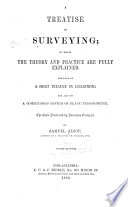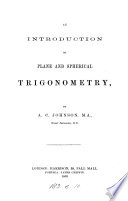 | Samuel Alsop - Surveying - 1865 - 440 pages
...place may be determined in various modes. 426. First Method.—By a meridian altitude of the Pole Star. The altitude of the pole is equal to the latitude of the place. Take the altitude of Polaris when on the meridian, and from the result subtract the refraction taken... | |
 | Alfred Challice Johnson - Plane trigonometry - 1865 - 166 pages
...drawn with PP inclined to the left, or P over the south point of the horizon. Ex. 1. To prove that the altitude of the pole is equal to the latitude of the place. In the fig. ZE is the arc of the meridian intercepted between the zenith of the place and the equator,... | |
 | Philip Thomas Main - Astronomy - 1868 - 224 pages
...vertical circle, and PSN a declination-circle, through S. Pn is the complement of PZ the co-latitude. Thus the altitude of the pole is equal to the latitude of the place. The great circle sZPn is the meridian, meeting the horizon in g and n the south and north points. PS... | |
 | Robert Main - Astronomy - 1869 - 212 pages
...observation. But p H is the altitude of the pole above the horizon. Hence we have this general rule, the altitude of the pole is equal to the latitude of the plact of observation. 68. Also zp, the arc included between the zenith and the pole, is the complement... | |
 | Alfred Challice Johnson - Spherical trigonometry - 1871 - 178 pages
...miles, their distance apart. Am. Bearing S. 83° 43' 45" W. Distance 43-87 miles. 1. To prove that the altitude of the pole is equal to the latitude of the place. In the fig. ZE is the arc of the meridian intercepted between the zenith of the place and the equator,... | |
 | John Brinkley - Astronomy - 1871 - 344 pages
...36. 15. Difference between terrestrial and celestial latitude and longitude? 36; 15. 16. Prove that the altitude of the pole is equal to the latitude of the place. 39. ] 7. Why will the heavenly horizon he a great circle ? 40. 18. Why are the days longer than the... | |
 | Victoria and Albert museum - 1876 - 550 pages
...PH, or the altitude of the pole at the place— thence we get this important fundamental rule that : The altitude of the pole is equal to the latitude of the place oj observation. Also, PZ is the complement of HP, that is 90°— HP, and is therefore the co-latitude... | |
 | Simon Newcomb - Astronomy - 1878 - 632 pages
...arrows. The two lower stare of Ursa Major, on the left of the map, point to the pole star in the centre. The altitude of the pole is equal to the latitude of the place. In the Middle States the latitude is generally not far from forty degrees ; the pole is therefore a... | |
 | John Merrifield - Nautical astronomy - 1886 - 376 pages
...meridian passage — Examples — Exercise — Examination . 93 CHAPTER VIII. On finding latitude — The altitude of the pole is equal to the latitude of the observer — -Latitude and declination found by the circnmmeridional altitudes of a star — Latitude... | |
 | George Albert Wentworth - Navigation - 1895 - 436 pages
...south of the body. PQ = ZH' (each being equal to 90°), taking away ZP, we have PH' — QZ; that is, the altitude of the pole is equal to the latitude of the observer. QZ = SZ+QS, or L = z + d. If the body is at S1, If the body is at S", QZ=QS"-ZS", or L=d—z.... | |
| |